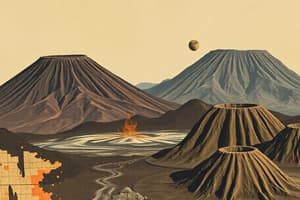Podcast
Questions and Answers
A volcano is an opening in the Earth's crust that allows solid rocks to escape from below the surface.
A volcano is an opening in the Earth's crust that allows solid rocks to escape from below the surface.
False (B)
Stratovolcanoes have a steep, conical shape and are built from alternating layers of lava flows, ash, and volcanic rocks.
Stratovolcanoes have a steep, conical shape and are built from alternating layers of lava flows, ash, and volcanic rocks.
True (A)
Cinder cone volcanoes are known for their broad, gently sloping sides.
Cinder cone volcanoes are known for their broad, gently sloping sides.
False (B)
Volcanic tsunamis can be triggered by underwater eruptions or landslides.
Volcanic tsunamis can be triggered by underwater eruptions or landslides.
The Mid-Atlantic Ridge is an example of a convergent boundary where two tectonic plates move apart.
The Mid-Atlantic Ridge is an example of a convergent boundary where two tectonic plates move apart.
Volcanic ash can disrupt air travel and damage infrastructure.
Volcanic ash can disrupt air travel and damage infrastructure.
Lava from shield volcanoes flows quickly and tends to be highly explosive.
Lava from shield volcanoes flows quickly and tends to be highly explosive.
Seismographs are used to measure gas emissions from volcanoes.
Seismographs are used to measure gas emissions from volcanoes.
Flashcards are hidden until you start studying
Study Notes
Definition of Volcanoes
- A volcano is an opening in the Earth's crust that allows molten rock, gases, and ashes to escape from below the surface.
Types of Volcanoes
-
Shield Volcanoes
- Broad, gently sloping sides.
- Built up by the flow of low-viscosity lava.
- Example: Mauna Loa in Hawaii.
-
Stratovolcanoes (Composite Volcanoes)
- Steep, conical shape.
- Alternating layers of lava flows, ash, and volcanic rocks.
- Example: Mount St. Helens in the USA.
-
Cinder Cone Volcanoes
- Small, steep-sided.
- Built from volcanic debris (cinders).
- Example: Paricutin in Mexico.
-
Lava Domes
- Formed from the slow extrusion of viscous lava.
- Dome-shaped and typically found within the craters of larger volcanoes.
- Example: Novarupta in Alaska.
Volcanic Activity
-
Eruptions
- Explosive: Associated with stratovolcanoes; propelled ash and gas into the atmosphere.
- Effusive: Slow lava flows typical of shield volcanoes.
-
Volcanic Gases
- Common gases include water vapor, carbon dioxide, sulfur dioxide, and hydrogen sulfide.
Volcanic Hazards
- Lava Flows: Can destroy everything in their path but tend to move slowly.
- Ash Falls: Can disrupt air travel, damage infrastructure, and affect respiratory health.
- Pyroclastic Flows: Fast-moving currents of hot gas and volcanic matter; highly destructive.
- Volcanic Tsunamis: Can be triggered by underwater eruptions or landslides.
Volcanism and Plate Tectonics
- Most volcanoes are located at tectonic plate boundaries:
- Divergent Boundaries: Plates move apart, allowing magma to rise (e.g., Mid-Atlantic Ridge).
- Convergent Boundaries: One plate subducts under another, leading to melting and magma formation (e.g., Pacific Ring of Fire).
Monitoring Volcanoes
- Seismographs: Measure earthquakes related to volcanic activity.
- Gas Emissions: Analysis of gas output can indicate changes in volcanic activity.
- Satellite Imagery: Used to track changes in landscape and thermal emissions.
Benefits of Volcanoes
- Fertile Soil: Volcanic ash contributes to nutrient-rich soil.
- Geothermal Energy: Heat from volcanic activity can be harnessed for energy.
- Tourism: Volcanoes attract visitors for their natural beauty and geological significance.
Definition of Volcanoes
- An opening in the Earth's crust that releases molten rock, gases, and ashes.
Types of Volcanoes
-
Shield Volcanoes
- Characterized by broad, gently sloping sides and formed by low-viscosity lava flows.
- Example: Mauna Loa in Hawaii.
-
Stratovolcanoes (Composite Volcanoes)
- Have a steep, conical shape with layers of lava flows, ash, and volcanic rocks.
- Example: Mount St. Helens in the USA.
-
Cinder Cone Volcanoes
- Small, steep-sided formations built from volcanic debris, such as cinders.
- Example: Paricutin in Mexico.
-
Lava Domes
- Formed by the slow extrusion of viscous lava, they are dome-shaped and found within the craters of larger volcanoes.
- Example: Novarupta in Alaska.
Volcanic Activity
-
Eruptions
- Explosive eruptions are typical of stratovolcanoes, launching ash and gas into the atmosphere.
- Effusive eruptions involve slow lava flows characteristic of shield volcanoes.
-
Volcanic Gases
- Common gases emitted include water vapor, carbon dioxide, sulfur dioxide, and hydrogen sulfide.
Volcanic Hazards
-
Lava Flows
- Move slowly but can destroy everything in their path.
-
Ash Falls
- Disrupt air travel, damage infrastructure, and pose health risks, particularly respiratory issues.
-
Pyroclastic Flows
- Fast-moving, hot currents of gas and volcanic material, highly destructive in nature.
-
Volcanic Tsunamis
- Can result from underwater eruptions or landslides associated with volcanic activity.
Volcanism and Plate Tectonics
- Most volcanoes are situated at tectonic plate boundaries:
- Divergent Boundaries: Where plates separate, allowing magma to ascend (e.g., Mid-Atlantic Ridge).
- Convergent Boundaries: Occur when one plate subducts beneath another, resulting in magma formation (e.g., Pacific Ring of Fire).
Monitoring Volcanoes
-
Seismographs
- Instruments that measure earthquakes linked to volcanic activity.
-
Gas Emissions
- Monitoring gas output helps indicate shifts in volcanic dynamics.
-
Satellite Imagery
- Useful in observing changes in landscape and thermal activity.
Benefits of Volcanoes
-
Fertile Soil
- Volcanic ash enriches soil, making it nutrient-dense for agriculture.
-
Geothermal Energy
- Harnessing heat from volcanic activity provides a source of energy.
-
Tourism
- Volcanoes draw visitors due to their natural beauty and geological importance.
Studying That Suits You
Use AI to generate personalized quizzes and flashcards to suit your learning preferences.




